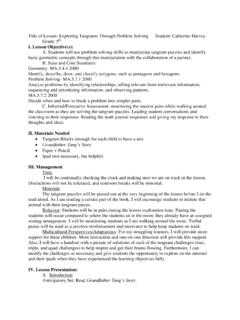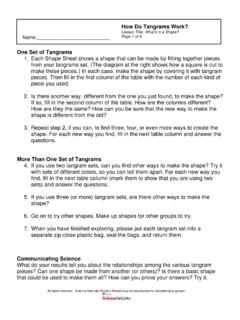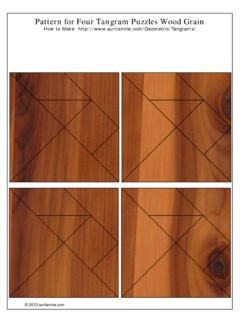Transcription of CHAPTER Moving with Giant Tangrams
1 Math Dance with Dr. Schaffer and Mr. Stern 2001 Schaffer, Stern, Kim 11 Moving with Giant TangramsMaking geometric shapes dance in spaceGrades:3 12 Time:20 60 minutesMath Concepts:Shape, angle, areaDance Concepts:Dance with props, spatial relationsGroup size:4-7 Space:Requires clear floorMaterials:One large tangram set per group (see instructions on page 109).Optional: pencil and paper, small tangram sets, rulerPrerequisites:NoneRelated Activities: CHAPTER 11 Moving with Giant Tangrams (follow-on activity) CHAPTER 10 Stick Figures (also involves Moving with large props) Tangrams , a geometric puzzle invented in China over 200 years ago, is played by millions of people allover the world, making it one of the most popular puzzles of all time. The goal of Tangrams is to arrangeseven simple shapes a square, parallelogram and five triangles to make silhouettes of animals,people, and other familiar figures.
2 In the early 1800s a woman in China named Shu Fen Shih wrote a bookcontaining over 1700 different figures. In the 1900s the great American puzzle inventor Sam Loyd createda gallery of 300 tangram faces, many of which are recognizable as particular people. Nowadays tangramsare a common classroom manipulative in elementary schools for teaching geometry and this CHAPTER you will read about movement games with Giant tangram pieces a foot or two in size,starting with solo exercises and working toward group exercises. By Moving Tangrams in space studentsdevelop their spatial visualization abilities and become acutely aware of geometric relationships. Theactivities in this CHAPTER can be used on their own, or as preparation for the next CHAPTER , Storytelling withGiant a few of these activities are similar to exercises with conventional small Tangrams , gianttangrams have several unique advantages.
3 Giant Tangrams require cooperation since one person cannot holdall the pieces. Because pieces can be seen across the room they lead naturally to performance andstorytelling. The spatial visualizationchallenges are harder since you cannot seethe shape you are making. Finally formingshapes with a group requires working outcomplex logistics among several forms of dance from around theworld use props, from Russian sworddances to Native American hoop groups like Cirque du Soleil useprops like Giant balls as part of precariousbalancing acts. Modern dance groups likethe Alwin Nikolais Dance Theater createdances of brightly colored shapes byhiding the performers in black costumesagainst a black Dance with Dr. Schaffer and Mr. Stern 2001 Schaffer, Stern, Kim 1 Moving Individually (5-10 minutes)Before beginning, make several sets of Giant Tangrams .
4 At a minimum make enough so each student hasone piece. For instructions, see section this activity, students learn to move Giant tangram pieces that are a foot or two in size. It is notnecessary to do every exercise, just enough so students feel comfortable with the prop. Clear the space by pushing desks to the side of your classroom. Or move the class to a gym or otherlarge space. Give each person one tangram piece. Have students stand in two lines facing each other,so they can see each other s shapes more clearly. For each of the following directions, have half the class move while the other half watches, thenswitch, so everyone gets to move and watch. After each exercise ask students to talk about what theysaw that did or did not work well. For instance, slow controlled motion is usually clearer than fastcareless motion.
5 Seeing what works when other people move is a good way to improve your ownmovement see the note on critiquing movement below. Explore the space. Hold your shape in one hand, move it around slowly without Moving your it as high as you can, as low as you can, in front of your neighbor to the left, and to the right. Change the angle. Twirl your shape by the handle. Turn it so it is as narrow as possible from left toright. Turn it so it as wide as possible. Explore different movement qualities. Move it slowly and smoothly. Move it staccatto, in suddenmovements with long pauses in between. Move the piece as if it were heavy and hard to move. Move itas if it were light as a feather. Keep it flat. Try Moving it so the front face stays flat in a plane, as if you were washing a big window, with the handle side toward you.
6 This is how you usually want to hold the Tangrams when you areperforming for an audience, because the shapes are clearest. Keep it still. Try keeping the shape still in space as if were glued to a pole while you move around,under and over it. How still can you hold the shape? Use your voice to add sound effects as you move your tangram pieces. What sounds work best withwhat movements? W often encourage students to add sound effects to all the tangram exercises in thischapter. In the next CHAPTER students add narration to their tangram Note: CritiqueLearning to look at dance is a big part of learning to move. When one is performing a dance, it is difficultto really see it, so it is important to get other people to say what they see. Encouraging students to talkabout their responses helps them become aware of their reactions, learn from each other, and develop aneye for dance.
7 Critiquing the work is a part of all the arts visual art, music, writing but is especiallyimportant in dance and theater where the performers are part of the art sorts of comments do we want students to give? We are not interested in whether a particularmovement conforms to a particular performance technique like an arabesque in ballet or a step-ball-changein jazz. All ways of Moving are , we are interested in which movements work best for the students as they watch the the students: What ways of Moving seem interesting? What catches your attention? What surprisesyou? What do you find distracting? What new ideas do you see that you might want to add to your owndances? Avoid personal remarks; comment on movement, not people. Sometimes it is fine to ask studentsto say what they liked, other times it is better to ask them to say what worked for course students may have different opinions about what is interesting.
8 That is okay. The overallgoal of critiquing dance should be for the class as a whole to build up a collective understanding of whattypes of movement work a teacher, also look for whether students move with clarity and authority. Whatever they are doing,are they doing it fully, with complete commitment? Often it is better not to suggest ways to fix problems,but merely to point them out. For more about critiquing dance, see CHAPTER 14, Dance with Dr. Schaffer and Mr. Stern 2001 Schaffer, Stern, Kim 2 Moving in Pairs (5 10 minutes)Try this exercise with half of each group Moving and half watching. The movers do the following: Find a partner and stand side by side. Hold your pieces in frontof you facing the audience, keeping them completely still. One of you slowly move your piece until it joins the otherperson s piece to make a shape.
9 Now the first person holds theirpiece still, while the second person slowly moves their piece untilit joins to make a different shape. Take turns Moving the pieces tomake different shapes. Only one person should move at a time. Now try Moving your pieces at the same time, always keepingthem in contact with each other. Move slowly so you don t losecontact. Optional: Join with another pair of people to make a group offour. See if you can move all four pieces at the same time, alwayskeeping pieces in contact with each other. After the movers have finished Moving , the watchers critique the motions by considering some thefollowing questions. There are no right and wrong answers to these questions, but the act of answeringthese questions will help everyone see what is going on.
10 What did you notice when the other group moved? For each type of movement, what worked? What did not work? What are the different ways you saw that people moved from one shape to another? What did you like or not like about the way pieces came into contact? How could you do it better? How could you do it differently? What feelings or images did different types of movement call to mind? What type of music would be appropriate for each type of movement? What other things move that way? 11 3 Moving in Groups (5 10 minutes)Divide students into groups of seven, each group holding a complete tangram set. If there are too fewpeople in a group, some people can hold more than one piece. For children ages eight and under, use fewerpieces and smaller groups. Make a shape with all pieces in your group.









